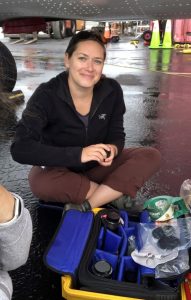Staff Spotlight: Cynthia Christman
Whales, seals, and polar bears, oh my! Cynthia Christman’s life as a research biologist has taken her to the Atlantic, Pacific, and Arctic oceans to study all sorts of marine mammals.
By Haley Staudmyer
 Cynthia started at the Marine Mammal Lab (MML) as a NOAA affiliate through CICOES in 2016. There, she works with the Polar Ecosystems Program, which focuses on researching and monitoring seals in Alaska. “I’m primarily involved with aerial surveys; all aspects of them, from planning and logistics to conducting the surveys and then processing the imagery and data that we come back with,” said Cynthia. She typically spends two to three months of the year in planes flying over Alaska to collect imagery and data on five species of seals.
Cynthia started at the Marine Mammal Lab (MML) as a NOAA affiliate through CICOES in 2016. There, she works with the Polar Ecosystems Program, which focuses on researching and monitoring seals in Alaska. “I’m primarily involved with aerial surveys; all aspects of them, from planning and logistics to conducting the surveys and then processing the imagery and data that we come back with,” said Cynthia. She typically spends two to three months of the year in planes flying over Alaska to collect imagery and data on five species of seals.
What is it like to be part of an aerial survey? While in the air, Cynthia’s job as a marine biologist is to spot seals, take photographs of them, and make notes on their behaviors. “It’s a small team of people. We usually have two pilots and three or four biologists in the back, so it’s a very tight-knit group of people. It’s almost like a surrogate family,” said Cynthia. “We’re working very closely in a potentially risky environment. We take a number of steps to mitigate those risks, and frequently do safety training together. It’s very much a collective team effort.”
The work is challenging but rewarding, and not just for the science that comes out of it. “It’s exciting being able to cover such a huge geographic area in the plane. It’s maybe a little bit more removed than if you were working hands-on with animals or on a ship, but you also cover so much more ground and you see just amazing landscape, especially up in Alaska,” said Cynthia. “This past year, some parts of our harbor seal surveys were over glacial fjords in Alaska, and the view was stunning. It’s beautiful, and it reminds you how small you are in comparison to many other things in life.”
Not everything seen from a bird’s eye view of the Arctic is so pleasant, though. The impacts of climate change become starkly visible in the air. “When I worked with the Cetacean Assessment and Ecology Program at MML, we did large-scale aerial surveys in the Arctic over the Chukchi and Beaufort seas. We started to see massive walrus haulouts form along the Alaskan coastline,” said Cynthia. The walruses are hauling themselves out of the water onto land rather than ice because sea ice cover has dwindled too much – the sea ice that remains is too far north for them. “Large walrus haulouts are normal for the Russian coast, but for the US, they were a relatively new phenomenon. Now they are a regular occurrence. It’s one thing to hear about drastic ecosystem changes from people that live along the coastline, that are seeing things shift over a period of decades or a lifetime. It’s another to actually see these changes in real time during a relatively short window of work.”
The Marine Mammal Lab’s aerial surveys come home with important and fascinating results. It’s more important than ever that the public be invested in the well-being of our natural world, and Cynthia has been trying to make that happen: “I’ve been starting to do more outreach activities, which is way out of my comfort zone. It’s still out of my comfort zone, but I’m trying to push myself to more of it because I think it’s important to connect with people and make research more accessible. It’s rewarding.”
Her advice for anyone pursuing their passions, scientific or otherwise? “Don’t let people try to talk you out of or put up roadblocks for things that are important to you,” said Cynthia. “I think you just have to rise above other people’s agendas and keep going.”
